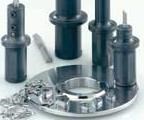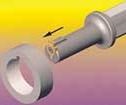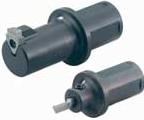Broaching On A Lathe
Producing a keyway, spline or similar longitudinal feature on a turned part usually necessitates an additional, time-consuming, secondary operation on a broaching or slotting machine. That means moving the part to and from a secondary operation, an extra setup, additional labor and hourly machine costs and all of the other headaches that go with secondary operations.
Producing a keyway, spline or similar longitudinal feature on a turned part usually necessitates an additional, time-consuming, secondary operation on a broaching or slotting machine. That means moving the part to and from a secondary operation, an extra setup, additional labor and hourly machine costs and all of the other headaches that go with secondary operations.
That is, assuming that you have the secondary machine. Grooves are made in so many different sizes and shapes that it is impractical for most shops to own their own machines and tooling. Many shops send out grooving work to firms that specialize in it, which increases the cost of the job accordingly.
Featured Content
Now, however, you may be able to produce those grooves on a CNC lathe, in the same setup used to produce the other features of the part. Horn USA, Inc. (Franklin, Tennessee), a producer of grooving tools for milling and turning machines, has introduced a line of tools designed to permit keyways, grooves and similar features to be machined directly on a CNC lathe. The tool is mounted on the machine’s tool turret with the other turning and rotary tools. It is fed into the workpiece with a reciprocating motion and is continuously adjusted by the machine’s CNC in the X and Y axes as required to produce the necessary slot width and depth. Parts that require several grooves spaced at regular intervals on the circumference of a bore will require that the CNC lathe have a C axis to perform the required indexing of the part.
The insert-type broaching tools have a round shank with broad flat clamping surfaces that are 90 degrees apart to permit mounting the tool on any type of CNC lathe. Other shanks or system receivers, such as DI, Capto or HSK, are also available.
Because the process takes advantage of the movement capabilities of the CNC lathe, a modest amount of tooling can be used to produce a wide range of groove sizes. For example, the company’s S105 tool system can be used to produce slots up to 4 mm wide by 12 mm or 15 mm long, in some cases with unlimited depth. An S117 tool system is available for grooves greater than 4 mm wide. The standard reach length range on System S117 is 40 mm or 50 mm, depending on the holder type. Horn stocks standard inserts with a range of corner radii and tolerance classes for the broaching tools.
Although the broaching rates obtained with a CNC lathe are probably less than that of a dedicated broaching or slotting machine, being able to perform the operation in house and perform it in the same setup with the other turning and milling operations adds considerably to a shop’s flexibility. The producer recommends the broaching tools for one-of-a-kind jobs, prototype work and small batch production.
Oil-based coolants or emulsions are recommended for use with the broaching tools. In addition to flushing chips from the bore, the oil-based coolants have a lubricating effect that improves the groove’s surface properties and promotes longer tool life. Where the application permits, the broaching operation should be performed with the tool at the 12 o’clock position so that the chips produced during cutting do not negatively affect the broaching cycle.
A brochure is available from the company that describes the complete line of broaching tools for CNC lathes. Toolholder and insert dimensions along with tooling recommendations for various groove sizes are provided.
RELATED CONTENT
-
Tools and Technologies for Deep Hole Drilling
Understanding the challenges of deep hole drilling and knowing how to select and apply the appropriate tools will help a shop profit from this operation.
-
Advantages of Cellular Manufacturing
Manufacturing cells are used to minimize product movement as well as materials, equipment and labor during the manufacturing process. By reducing cycle times and material handling, these cells help shops more easily meet customer demands regarding cost, quality and leadtimes.
-
Collets Vs. Chucks
Find the definition, types and advantages of both CNC collets and chucks for workholding as well as the best applications for each, in this article.









